Mad Hedge Biotech & Healthcare Letter
July 22, 2021
Fiat Lux
FEATURED TRADE:
(ANOTHER STEP CLOSER TO NEURO-VICTORY)
(BAYRY), (BIIB), (LLY), (SIOX), (RHHBY), (ABBV), (MRK), (PFE), (AZN)

Mad Hedge Biotech & Healthcare Letter
July 22, 2021
Fiat Lux
FEATURED TRADE:
(ANOTHER STEP CLOSER TO NEURO-VICTORY)
(BAYRY), (BIIB), (LLY), (SIOX), (RHHBY), (ABBV), (MRK), (PFE), (AZN)

First, Alzheimer’s. Now, Parkinson’s.
Companies working on neurodegenerative diseases are on a roll.
After Biogen’s (BIIB) work with Aduhelm, another biopharmaceutical company has made notable progress: Bayer (BAYRY).
Merely six weeks after DA01 landed in the clinic, Bayer’s Parkinson’s disease drug candidate is getting into the fast lane.
This marks one of the major pipeline candidates that the German company picked up from its $1 billion acquisition of Versant Ventures in 2019.
DA01 is described as a “pluripotent stem cell-derived dopaminergic neuron therapy.”
In layman’s terms, Bayer collects donor cells that have the ability to develop into any other cell type in the body.
It will then engineer these versatile cells to turn into neurons that have the capacity to produce the neurotransmitter dopamine—aka the chemical your nervous system uses to transmit messages to nerve cells.
Those engineered neurons will then be transplanted into a part of the brain, called the putamen, which is in charge of our movements and learning.
What we know so far is that the next phase of the trial will determine the safety and tolerability of the cell transplantation a year following the procedure.
This will also tell us more about the cell survival rate after the transplant and the motor effects a year or two following the procedure.
Like Biogen’s Alzheimer’s candidate, the fast-track designation with the FDA could open doors for a speedy review or even an accelerated approval for Bayer’s DA01.
Aside from transplanting engineered cells into patients’ brains, the company is also looking into other options for Parkinson’s.
In October 2020, it shelled out $2 billion upfront to acquire Asklepios BioPharmaceutical or AskBio for its gene therapy research on Parkinson’s.
Roughly 1 million people in the US are suffering from Parkinson’s disease—a number that’s greater than the combined number of patients diagnosed with Lou Gehrig’s disease, multiple sclerosis, and muscular dystrophy.
What’s worse is that this is expected to climb to 1.2 million by 2030.
In terms of treatment cost, the combined expenses for Parkinson’s, including medical bills and lost income, are estimated to reach about $52 billion annually in the US alone.
The medications alone already amount to an average of $2,500 per year, with therapeutic surgery reaching up to $100,000 per person.
This is why it comes as no surprise that several companies have been working towards figuring out a more potent treatment or even cure for Parkinson’s.
One of the frontrunners is Prevail Therapeutics, a New York-based biotechnology company that’s focused on developing a gene therapy for this disease.
Following a successful Series B financing round in 2019, in which it secured $50 million in investments, the company eventually attracted the attention of big pharma.
By December 2020, it was acquired by Eli Lilly (LLY) for $880 million with the promise to help the smaller biotech company develop three of its most promising Parkinson’s candidates.
Another Parkinson’s-centered biotech company is Axovant Gene Therapies, which has been working on a single-dose treatment for neurodegenerative disease.
Its pipeline proved to be promising, as seen in its $74.7 million public offering just last February 2020, with the company maintaining its solid footing amid the pandemic.
By November, it rebranded itself as Sio Gene Therapies (SIOX).
Outside the US is Irish biotech firm Inflazome, which is working on a unique treatment for Parkinson’s.
Unlike the other candidates, the goal of Inflazome’s drug is to directly deliver the treatment to the affected neurons. That is, it plans to pass through the blood-brain barrier.
Its research attracted the Michael J. Fox Foundation, which granted it $1 million in funding, in March 2019.
Since then, the company’s progress has attracted the attention of other major biopharmaceutical companies with Roche (RHHBY), ultimately landing the acquisition in September 2020.
Of course, talks about neurodegenerative diseases wouldn’t be complete without Biogen.
On top of its Alzheimer’s work, the Massachusetts biotechnology giant has been collaborating with San Francisco-based Parkinson’s company Denali Therapeutics.
The two have been working on the development of three small molecular drugs for $560 million in upfront payments plus $465 million in equity investment into the smaller biotech.
In addition to these, we’re still waiting on what the rest of the major biopharmaceutical companies would come up with in the future.
Given that the likes of AbbVie (ABBV), Merck (MRK), Pfizer (PFE), and AstraZeneca (AZN) have all signed up publicly via the Critical Path for Parkinson's (CPP) consortium to tackle this debilitating disease, it’s safe to say that there’s hope for the future of this sector.
First, Alzheimer’s. Now, Parkinson’s.
Companies working on neurodegenerative diseases are on a roll.
After Biogen’s (BIIB) work with Aduhelm, another biopharmaceutical company has made notable progress: Bayer (BAYRY).
Merely six weeks after DA01 landed in the clinic, Bayer’s Parkinson’s disease drug candidate is getting into the fast lane.
This marks one of the major pipeline candidates that the German company picked up from its $1 billion acquisition of Versant Ventures in 2019.
DA01 is described as a “pluripotent stem cell-derived dopaminergic neuron therapy.”
In layman’s terms, Bayer collects donor cells that have the ability to develop into any other cell type in the body.
It will then engineer these versatile cells to turn into neurons that have the capacity to produce the neurotransmitter dopamine—aka the chemical your nervous system uses to transmit messages to nerve cells.
Those engineered neurons will then be transplanted into a part of the brain, called the putamen, which is in charge of our movements and learning.
What we know so far is that the next phase of the trial will determine the safety and tolerability of the cell transplantation a year following the procedure.
This will also tell us more about the cell survival rate after the transplant and the motor effects a year or two following the procedure.
Like Biogen’s Alzheimer’s candidate, the fast-track designation with the FDA could open doors for a speedy review or even an accelerated approval for Bayer’s DA01.
Aside from transplanting engineered cells into patients’ brains, the company is also looking into other options for Parkinson’s.
In October 2020, it shelled out $2 billion upfront to acquire Asklepios BioPharmaceutical or AskBio for its gene therapy research on Parkinson’s.
Roughly 1 million people in the US are suffering from Parkinson’s disease—a number that’s greater than the combined number of patients diagnosed with Lou Gehrig’s disease, multiple sclerosis, and muscular dystrophy.
What’s worse is that this is expected to climb to 1.2 million by 2030.
In terms of treatment cost, the combined expenses for Parkinson’s, including medical bills and lost income, are estimated to reach about $52 billion annually in the US alone.
The medications alone already amount to an average of $2,500 per year, with therapeutic surgery reaching up to $100,000 per person.
This is why it comes as no surprise that several companies have been working towards figuring out a more potent treatment or even cure for Parkinson’s.
One of the frontrunners is Prevail Therapeutics, a New York-based biotechnology company that’s focused on developing a gene therapy for this disease.
Following a successful Series B financing round in 2019, in which it secured $50 million in investments, the company eventually attracted the attention of big pharma.
By December 2020, it was acquired by Eli Lilly (LLY) for $880 million with the promise to help the smaller biotech company develop three of its most promising Parkinson’s candidates.
Another Parkinson’s-centered biotech company is Axovant Gene Therapies, which has been working on a single-dose treatment for neurodegenerative disease.
Its pipeline proved to be promising, as seen in its $74.7 million public offering just last February 2020, with the company maintaining its solid footing amid the pandemic.
By November, it rebranded itself as Sio Gene Therapies (SIOX).
Outside the US is Irish biotech firm Inflazome, which is working on a unique treatment for Parkinson’s.
Unlike the other candidates, the goal of Inflazome’s drug is to directly deliver the treatment to the affected neurons. That is, it plans to pass through the blood-brain barrier.
Its research attracted the Michael J. Fox Foundation, which granted it $1 million in funding, in March 2019.
Since then, the company’s progress has attracted the attention of other major biopharmaceutical companies with Roche (RHHBY), ultimately landing the acquisition in September 2020.
Of course, talks about neurodegenerative diseases wouldn’t be complete without Biogen.
On top of its Alzheimer’s work, the Massachusetts biotechnology giant has been collaborating with San Francisco-based Parkinson’s company Denali Therapeutics.
The two have been working on the development of three small molecular drugs for $560 million in upfront payments plus $465 million in equity investment into the smaller biotech.
In addition to these, we’re still waiting on what the rest of the major biopharmaceutical companies would come up with in the future.
Given that the likes of AbbVie (ABBV), Merck (MRK), Pfizer (PFE), and AstraZeneca (AZN) have all signed up publicly via the Critical Path for Parkinson's (CPP) consortium to tackle this debilitating disease, it’s safe to say that there’s hope for the future of this sector.
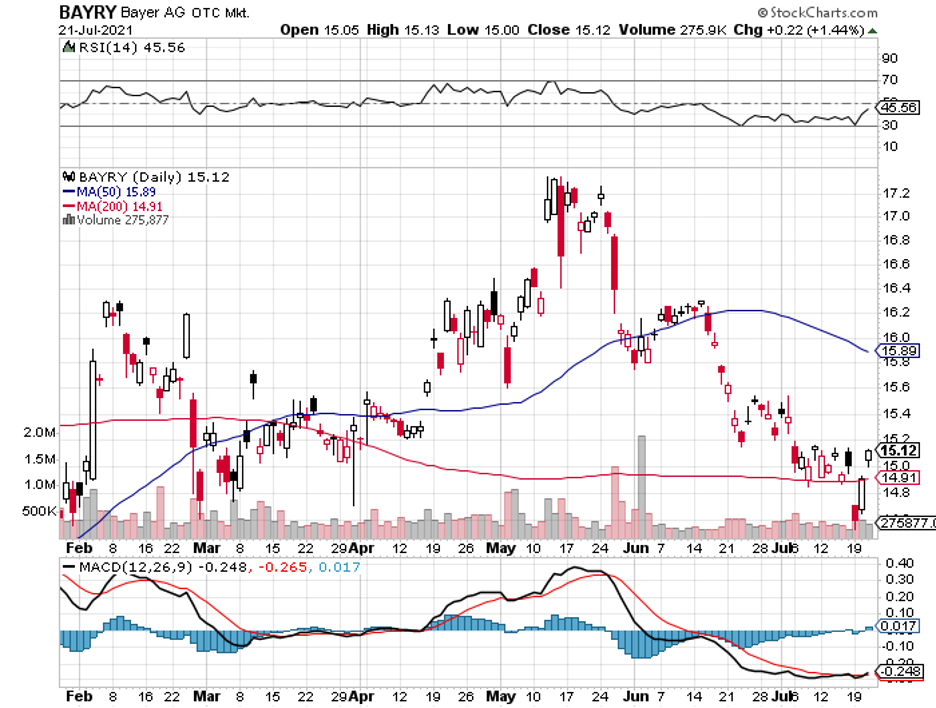
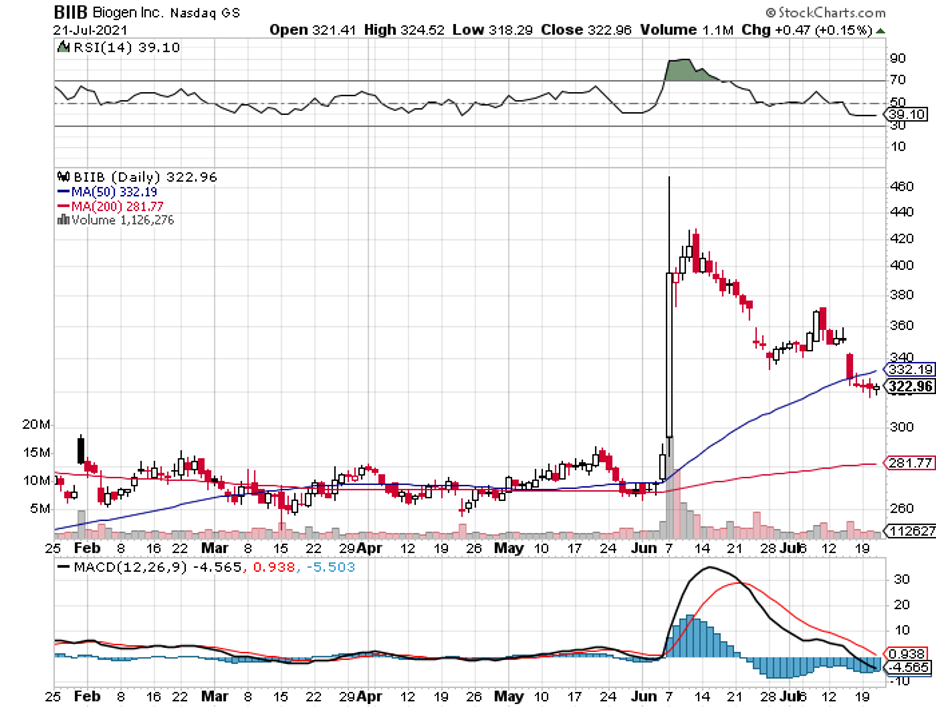
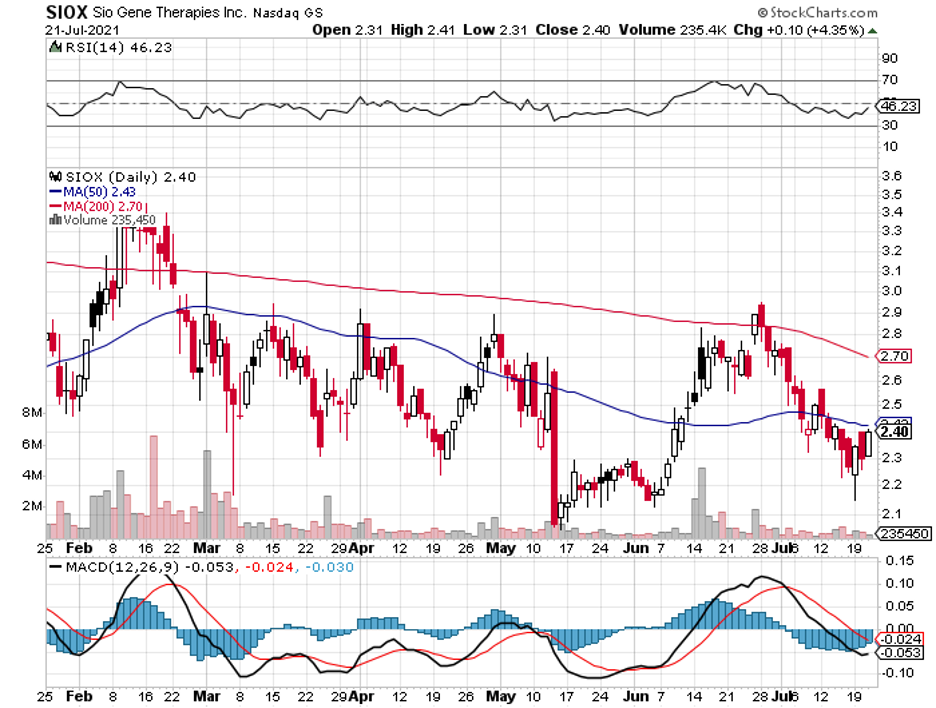
Mad Hedge Biotech & Healthcare Letter
May 20, 2021
Fiat Lux
FEATURED TRADE:
(REGENERATED REGENERON)
(REGN), (PFE), (JNJ), (AMGN), (BMY), (GILD), (MRK), (LLY), (SNY), (BAYRY), (NVS), (RHHBY)
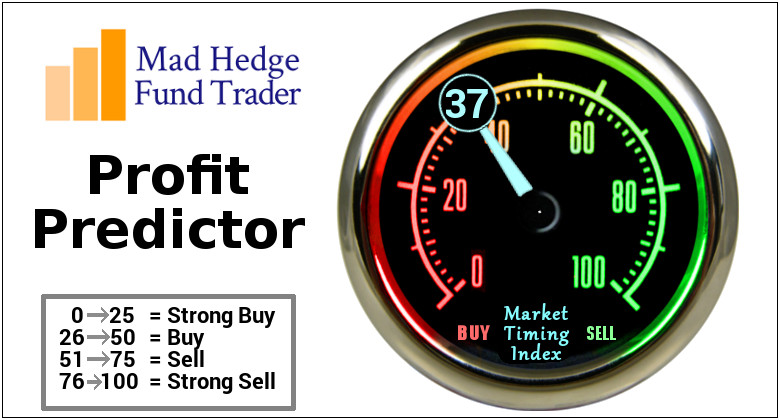
The biotechnology and healthcare sectors have become attractive investment targets for investors who recognize the value and essence of these industries along with the possible risks associated with them.
While not all companies in these areas are great investments, some offer remarkable growth opportunities.
One company worth considering is Regeneron (REGN), with its strong and stable investment thesis and steady organic growth.
Regeneron joins the ranks of Pfizer (PFE) and Johnson & Johnson (JNJ) as one of the handful of biopharmaceutical companies to release solid first quarter results this 2021 compared to other big names in the industry, including Amgen (AMGN), Bristol Myers Squibb (BMY), Gilead Sciences (GILD), Merck (MRK), and Eli Lilly (LLY).
The New York-based company reported a 38% boost in its revenue compared to the same period in 2020, reaching $2.5 billion for the first quarter of 2021 alone.
Virtually all of Regeneron’s products generated solid growth during this period, with the company’s COVID-19 antibody cocktail REGEN-COV delivering the highest sales at $262 million.
To underscore just how significant REGEN-COV is to Regeneron this quarter, its absence from the roster would take away 18% from the company’s overall revenue growth.
Riding the momentum of its COVID-19 program, Regeneron has developed Inmazeb, which is a treatment for Ebola virus infection.
Aside from its COVID-19 antibody cocktail, Regeneron also saw an impressive boost in the performance of its atopic dermatitis drug Dupixent.
Dupixent, which Regeneron sells in partnership with Sanofi (SNY), generated $1.26 billion in sales in the first quarter, showing off a notable 48% increase from its 2020 report.
Although Dupixent is a shared product with Sanofi, this dermatitis drug holds incredible promise for Regeneron.
To date, only 6% of eligible patients are being treated with Dupixent. This indicates a massive space that is yet to be explored by both companies.
Taking into consideration the pace at which Dupixent has been growing so far, this drug is projected to peak at roughly $12.5 billion in sales in the coming years.
Another high-selling drug for Regeneron is wet age-related macular degeneration (AMD) treatment Eylea.
Sales for this drug, which was developed in collaboration with Bayer (BAYRY), went up from $1.2 billion in the first quarter of 2020 to $1.3 billion this year.
The increase in sales for Eylea is a welcome surprise for both Regeneron and Bayer, especially since more and more competitors are attempting to topple the drug as the top product in the niche.
Cornering the AMD segment is an attractive venture for any biopharmaceutical company.
After all, Eylea generated $4.9 billion in sales in 2020 from the US market alone.
Thus far, two main competitors have come forward as the strongest.
One is Novartis (NVS), which released Beovu in 2019.
The second, and possibly the stronger competitor between the two, is Roche (RHHBY) with Faricimab.
To ensure its dominance in the AMD market, Regeneron has been expanding the use of Eylea.
The latest development is the drug’s enrollment in the Phase 3 program, which would allow extended periods in between treatments but still deliver the same level of efficacy and safety.
Aside from these, Regeneron is looking into additional revenue streams ahead.
One growth segment is its oncology program, particularly its cancer drug Libtayo, which may soon be marketed to cover a fourth type of cancer.
Regeneron aims to submit Libtayo for review as a treatment for advanced cervical cancer.
On top of this, the drug is also a strong contender in the development of several antibody treatments.
Thus far, the company has 12 oncology antibodies under clinical development.
Overall, Regeneron’s strong results for the first quarter of 2021 highlighted its continuous evolution into a company carrying multiple and diverse portfolios of products and pipeline programs that address an extensive range of serious diseases, from COVID-19 and rare diseases to cancer.
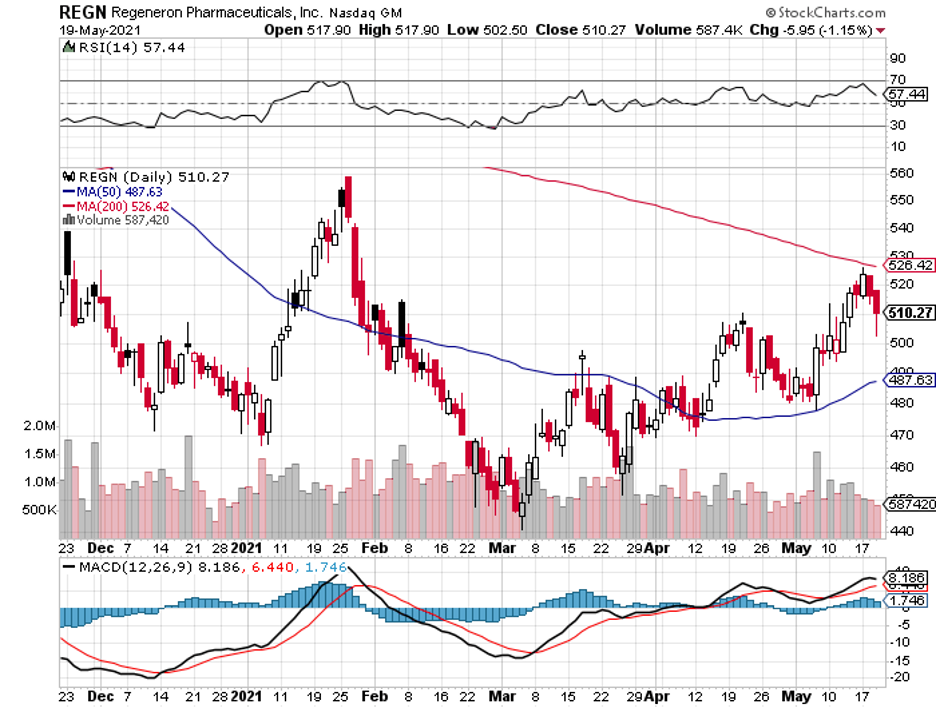
Mad Hedge Biotech & Healthcare Letter
August 27, 2020
Fiat Lux
Featured Trade:
(THE FUTURE OF GENE-EDITING TECHNOLOGY)
(CRSP), (VRTX), (BAYRY), (NTLA), (NVS), (EDIT), (BMY)
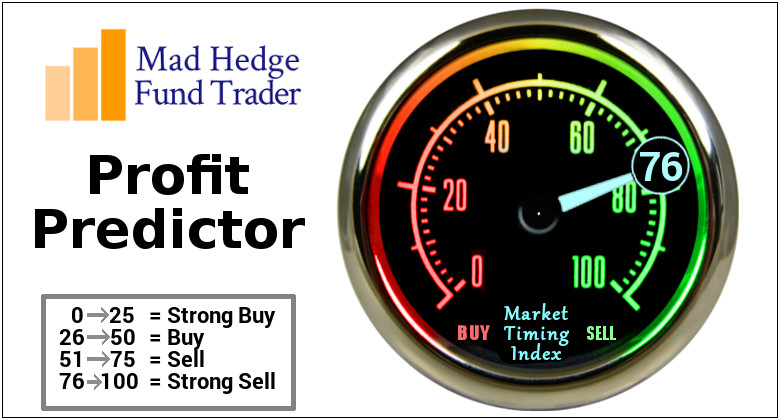
There are wise investments, and there are excellent investments.
CRISPR Therapeutics (CRSP) has been proving to qualify in the latter category.
In fact, the company is considered one of the best biotechnology stocks to own during these turbulent times. It is estimated to dominate the gene-editing therapy market, which will reach roughly $11.2 billion in worth by 2025.
Four years ago, CRISPR Therapeutics stock was trading at $14.09. Today, each share is worth $90.35.
This means that CRISPR Therapeutics biotechnology company has been trading for 540% more than its value since it went public in 2016.
This is a remarkable pace for a biotechnology stock, with CRISPR Therapeutics raking in $289 million in trailing 12-month revenue thanks to strategic collaborations.
It even has a decent $890 million stored in cash, with the company reporting a 16% profit margin despite not having any treatment or drug available in the market yet.
More importantly, CRISPR Therapeutics holds a novel position of being under absolutely zero pressure to push a product out the door.
Nonetheless, the investor confidence in CRISPR Therapeutics relies heavily on the company’s leading position in the groundbreaking world of gene-altering treatments.
Basically, the company specializes in creating and developing therapies for genetic diseases with either no cure available or require frequent transfusions.
Looking at the results of the recent tests on the company’s pipeline candidates, CRISPR Therapeutics is projected to transform into a household name in the next five to 10 years.
CRISPR Therapeutics has five cell therapy candidates in the clinical stage. Three of these target immuno-oncology, while the two are designed for genetic blood disorders like beta-thalassemia sickle cell disease.
Among the five, the most advanced is CRISPR Therapeutics’ collaborative work with Vertex Pharmaceuticals (VRTX) on beta-thalassemia therapy CTX001.
This candidate received a fast-track designation from the FDA, with CRISPR Therapeutics releasing promising preliminary results recently.
However, it is another Vertex collaboration drug that actually yielded CRISPR Therapeutics $25 million at the beginning of 2020.
The drug, which is developed to treat muscular dystrophy disorder, is expected to account for approximately $800 million in future milestone payments in the next few years.
Although the genetic blood disorder programs are raking in millions these days, CRISPR Therapeutics’ cancer treatment pipeline offers an even greater potential in terms of stable revenue streams.
The company is utilizing a gene-editing platform, called CRISPR/Cas9, to create “off the shelf” novel chimeric receptor (CAR) T-cells.
If successful, then CRISPR Therapeutics can use a single batch to treat a broad group of cancer patients.
This is groundbreaking because the typical way involves harvesting T-cells from the patients, tailor-fitting the therapies, then re-introducing the cells to the body.
With this technology, CRISPR Therapeutics can easily cover more markets and offer regular treatments for patients within shorter intervals.
That’s why it comes as no surprise that a major biotechnology player like Bayer (BAYR) reached out to the smaller company for a collaboration.
The CAR T-cell market is projected to hit $8.4 billion by 2027, with an estimated compound annual growth rate of roughly 15%.
Specifically, CRISPR Therapeutics expects this product to become a leader in the solid tumor cancer therapy space, pegged to reach $425 billion by 2027.
However, it is not only CRISPR Therapeutics that is widely known in the gene-editing sector.
To date, the company has two close competitors: Intellia Therapeutics (NTLA), which has a strategic partnership with Novartis (NVS), and Editas Medicine (EDIT), which is working alongside Bristol Myers-Squibb (BMY).
Both are also using the CRISPR/Cas9 technology to come up with treatments.
Although Intellia Therapeutics and Editas went public the same year as CRISPR Therapeutics, neither has performed quite as well.
For perspective, CRISPR Therapeutics currently has a market capitalization of $6.3 billion. In comparison, Intellia Therapeutics has $1.13 billion while Editas Medicine has $2.13 billion.
Keep in mind though that clinical-stage companies, particularly in the biotechnology sector, are inherently risky plays.
Among the companies in the space, CRISPR Therapeutics is emerging to be a solid bet not only from a cash perspective but also based on its strong pipeline and profitable collaborations.
Overall, CRISPR Therapeutics is still considered a high-risk option.
Hence, the safest way to invest is to build a carefully hedged portfolio filled with well-researched gene-editing stocks. This will minimize your risks and guarantee your exposure to the upside in case any of your chosen biotechnology companies makes it to the market with a groundbreaking therapy.
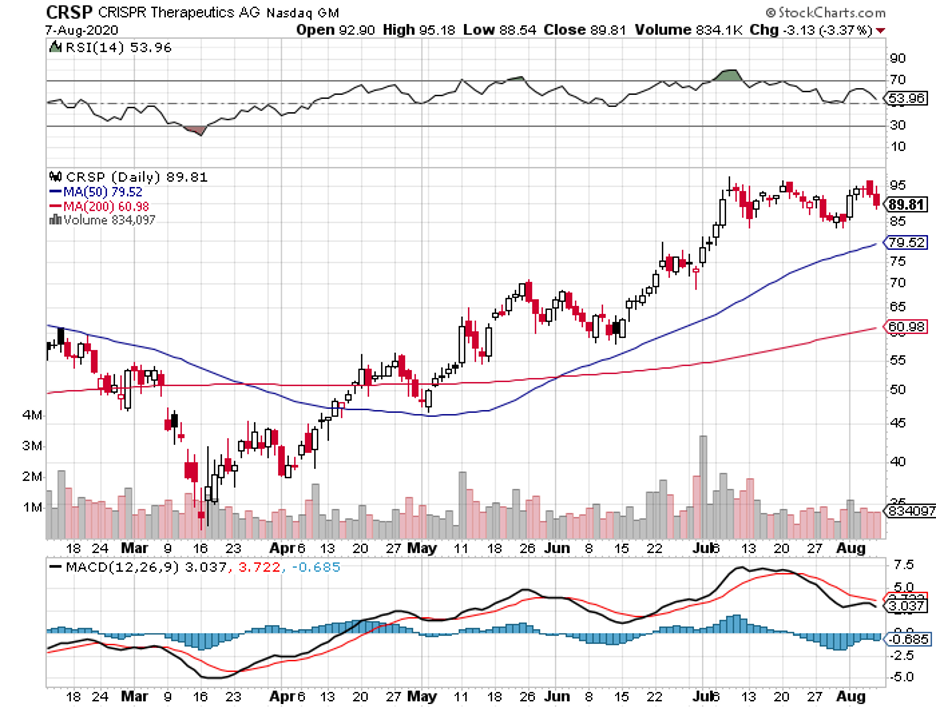
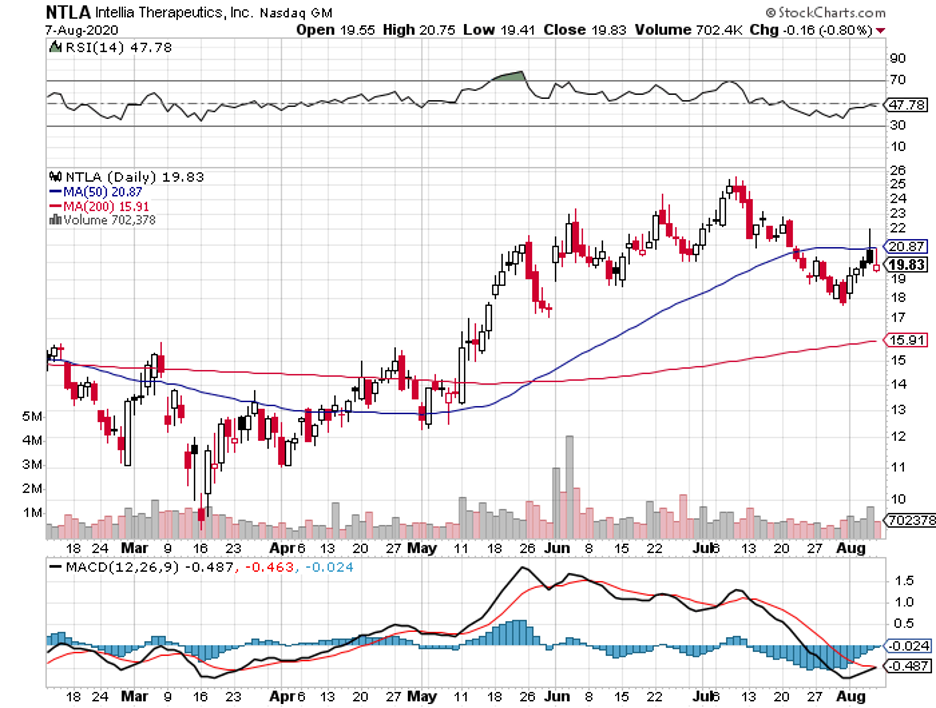
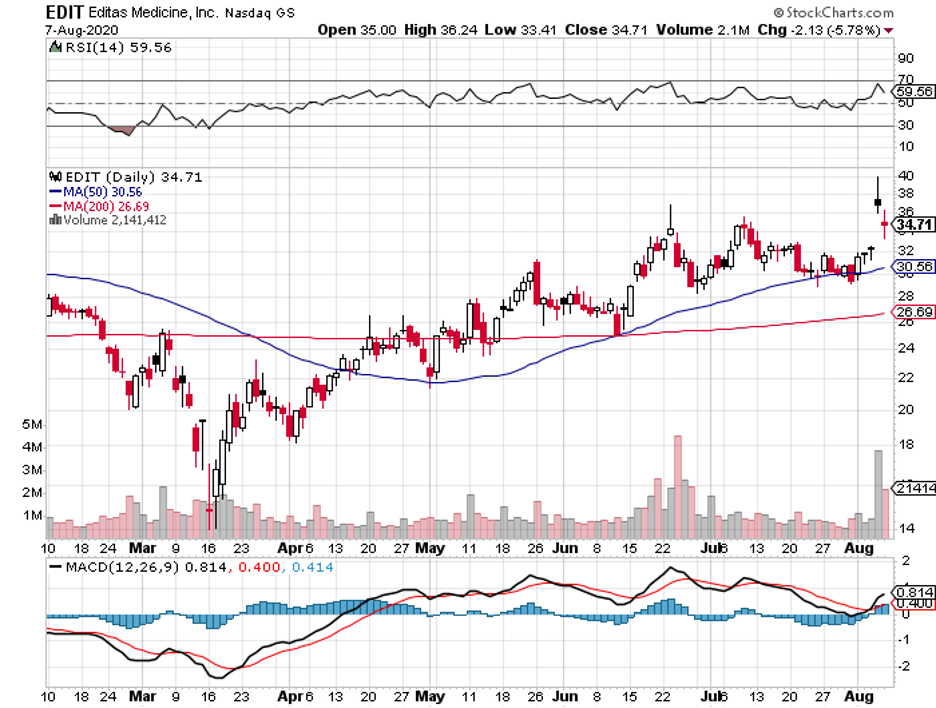
Mad Hedge Biotech & Healthcare Letter
April 9, 2020
Fiat Lux
Featured Trade:
(A SLIVER OF HOPE FOR CORONAVIRUS)
(MYL), (NVS), (BAYRY), (PFE)
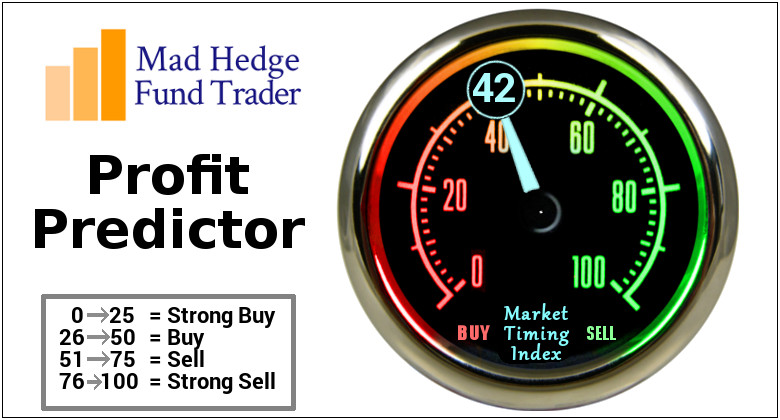
To this day, there’s still no solid proof that any drug can treat or prevent infection with the deadly coronavirus. Faced with an exploding pandemic that brings an alarming death toll, the public is eager -- desperate -- for a sliver of hope and some news regarding discoveries of COVID-19 treatment.
Lately, the drug that has been gaining so much attention is hydroxychloroquine. This is primarily thanks to Trump’s endorsement, with the president going as far as labeling it a “miracle” drug.
By now, we’ve become all too familiar with the story behind this “miracle” drug.
Trump was watching TV the night before and saw a feature about a Michigan woman who was suffering from COVID-19 for 12 to 14 days. Her suffering was so intense that she felt she would die anytime soon. One night, she asked her husband to find hydroxychloroquine.
Four hours after taking it, she felt better and eventually recovered.
While health experts are still waiting for conclusive evidence on the drug’s efficacy, this story inspired Trump to urge the public to try it as well.
Aside from describing it as a potential cure, Trump is also recommending hydroxychloroquine as a preventive measure for health workers. His point is that there’s really nothing to lose here. After all, the drug has been used for decades so “it’s not going to kill anybody” compared to completely novel treatments.
In fact, he has been so intent in using hydroxychloroquine to cure COVID-19 patients that he ordered 29 million doses added to the government’s cache of medical supplies.
Just what is hydroxychloroquine?
This is a prescription drug approved to treat malaria decades ago. It can also be prescribed to treat autoimmune diseases such as lupus and rheumatoid arthritis. It’s called by its brand name Plaquenil as well.
Is it really effective to treat COVID-19?
The answer remains unclear. However, there are a couple of studies that point to promising results.
One is a laboratory study using cultured cells. In this research, it was found that chloroquine has the ability to prevent the coronavirus from invading the cells. Obviously, blocking the virus means protecting the body from the illness.
However, scientists issued a word of caution about this.
They reminded us that the drugs that work well in killing off viruses in petri dishes or test tubes do not necessarily translate to the same results in the human body.
As for hydroxychloroquine, studies showed that it can’t prevent or cure influenza and other viral diseases.
This doesn’t mean that hydroxychloroquine is useless as a COVID-19 treatment.
It just shows that more trials are needed to determine its actual effect. Several studies have been launched to figure out the answer to this.
In Detroit alone, there will be 3,000 patients set to participate in the trial to come up with a formal and conclusive study on hydroxychloroquine.
In a nutshell, what the health experts are saying is that the celebration might be a tad premature.
So this leads to a lot of investors to wonder which companies stand to benefit if hydroxychloroquine gets approved as a COVID-19 treatment.
Probably no one.
Keep in mind that this is an old drug, which came to the market sometime in the 1940s. Hence, it’s highly unlikely for it to become a blockbuster drug for any company.
Right now, several companies are already making it, including Novartis (NVS) and Bayer (BAYRY).
However, investors interested in buying cheap biotech stocks might be interested in generic drug maker and Mylan (MYL) are also in the running.
When Trump started touting the effects of hydroxychloroquine on COVID-19 patients, Mylan immediately restarted its production of the tablets.
The company aims to have the drug available in the market by mid-April, targeting up to 50 million tablets for over 1.5 million people.
Like I said, hydroxychloroquine isn’t going to be a high-selling drug for any company.
Nonetheless, this could provide the much-needed momentum for Mylan as its investors start to lose confidence in the company.
With the company back in the spotlight, it can easily redirect everyone’s attention to its upcoming merger with Pfizer’s (PFE) Upjohn unit to form a new company called Viatris.
This combined company will hit the ground running as it buys two assets from Pfizer.
One will be Meridian, which is the maker of EpiPen along with other auto-injectible treatments. The second is Mylan-Japan, which has been the generics collaboration unit of Pfizer and Mylan since 2012.
Both units recorded $598 million in annual revenue in 2019.
Viatris’ portfolio will also include a number of top-selling products like erectile dysfunction and pulmonary arterial hypertension Viagra and arthritis Celebrex.
The lineup will even feature the blockbuster cholesterol drug Lipitor, which generated more than 2 billion in sales last year alone.
According to the terms of the deal, Pfizer shareholders will own 57% of Viatris while Mylan shareholders get 43%.
Due to the upcoming merger, Pfizer went ahead and upped the 2020 guidance for Upjohn’s revenue from the $7.5 billion and $8 billion range to $8 billion and $8.5 billion.
The Viatris spin-off is expected to be completed by mid-2020.
For years, Mylan has been plagued with numerous issues like pricing concerns and even lawsuits.
Hence, this merger with Upjohn is considered a crucial turning point for Mylan. It represents a fresh beginning from this previously embattled stock.
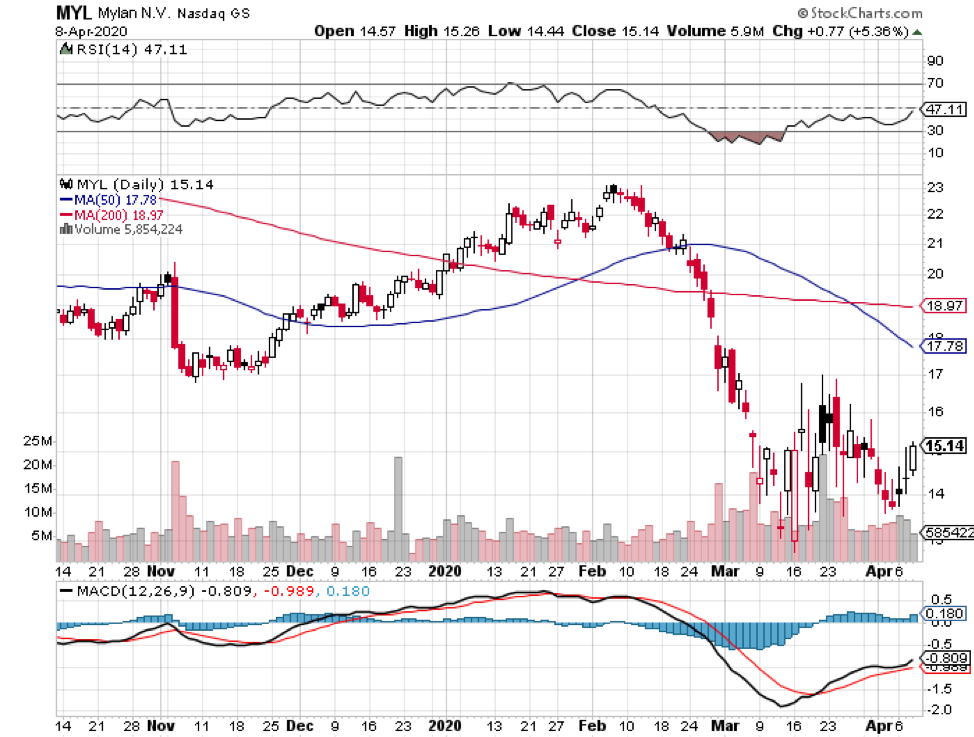
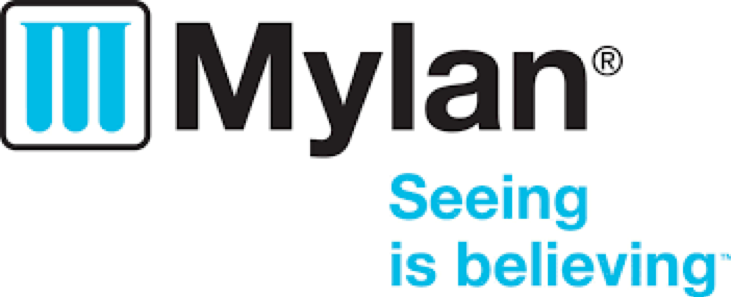
Legal Disclaimer
There is a very high degree of risk involved in trading. Past results are not indicative of future returns. MadHedgeFundTrader.com and all individuals affiliated with this site assume no responsibilities for your trading and investment results. The indicators, strategies, columns, articles and all other features are for educational purposes only and should not be construed as investment advice. Information for futures trading observations are obtained from sources believed to be reliable, but we do not warrant its completeness or accuracy, or warrant any results from the use of the information. Your use of the trading observations is entirely at your own risk and it is your sole responsibility to evaluate the accuracy, completeness and usefulness of the information. You must assess the risk of any trade with your broker and make your own independent decisions regarding any securities mentioned herein. Affiliates of MadHedgeFundTrader.com may have a position or effect transactions in the securities described herein (or options thereon) and/or otherwise employ trading strategies that may be consistent or inconsistent with the provided strategies.
This site uses cookies. By continuing to browse the site, you are agreeing to our use of cookies.
OKLearn moreWe may request cookies to be set on your device. We use cookies to let us know when you visit our websites, how you interact with us, to enrich your user experience, and to customize your relationship with our website.
Click on the different category headings to find out more. You can also change some of your preferences. Note that blocking some types of cookies may impact your experience on our websites and the services we are able to offer.
These cookies are strictly necessary to provide you with services available through our website and to use some of its features.
Because these cookies are strictly necessary to deliver the website, refuseing them will have impact how our site functions. You always can block or delete cookies by changing your browser settings and force blocking all cookies on this website. But this will always prompt you to accept/refuse cookies when revisiting our site.
We fully respect if you want to refuse cookies but to avoid asking you again and again kindly allow us to store a cookie for that. You are free to opt out any time or opt in for other cookies to get a better experience. If you refuse cookies we will remove all set cookies in our domain.
We provide you with a list of stored cookies on your computer in our domain so you can check what we stored. Due to security reasons we are not able to show or modify cookies from other domains. You can check these in your browser security settings.
These cookies collect information that is used either in aggregate form to help us understand how our website is being used or how effective our marketing campaigns are, or to help us customize our website and application for you in order to enhance your experience.
If you do not want that we track your visist to our site you can disable tracking in your browser here:
We also use different external services like Google Webfonts, Google Maps, and external Video providers. Since these providers may collect personal data like your IP address we allow you to block them here. Please be aware that this might heavily reduce the functionality and appearance of our site. Changes will take effect once you reload the page.
Google Webfont Settings:
Google Map Settings:
Vimeo and Youtube video embeds:
